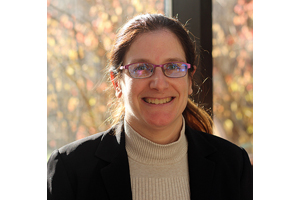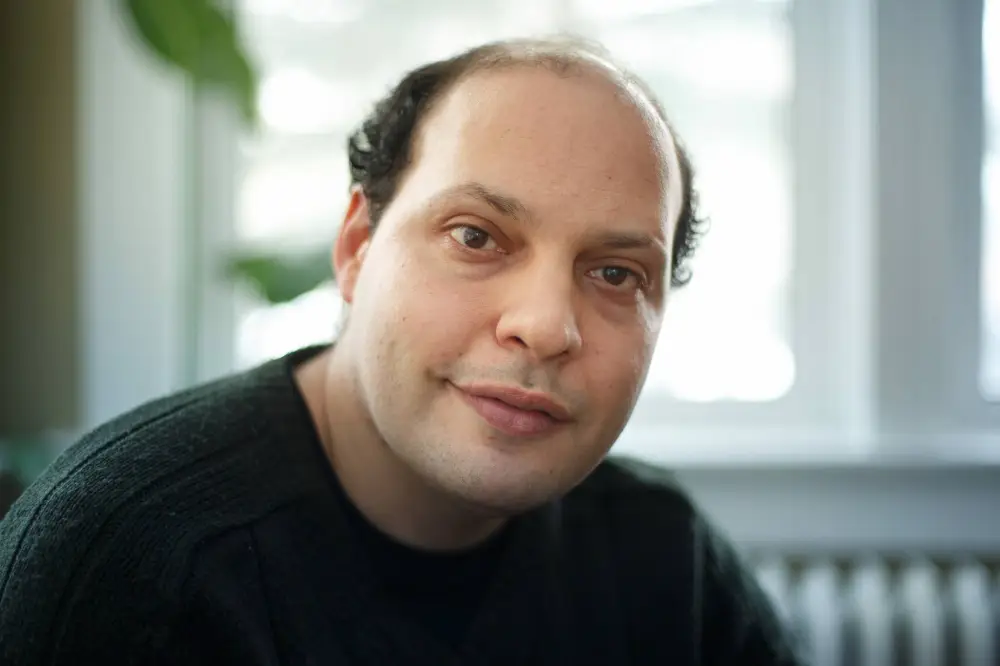Local News
Melanie Martin (née Schachter) blazes trail for women in science

By MYRON LOVE In 1993, then University of Manitoba physics student Melanie Schachter had the honour of being one of just two Canadian students chosen by an organization called the Youth Science Foundation to represent our country at the Nobel Prize ceremonies and the 18th annual Stockholm International Youth Science Seminar that year.
Her selection was based on her academic achievements – including a $37,000 National Research Council Canada Women in Engineering and Sciences Scholarship and a Natural Sciences and Engineering Research Council of Canada undergraduate student research award – as well as her efforts to encourage girls in high school to consider careers in science.
Now, 25 years later after graduating from the University of Manitoba (1995) with a B.Sc. Honours in Physics, Dr. Melanie Martin – in her position as a professor of physics at the University of Winnipeg – remains a trailblazer for women in science. The daughter of the former editor of The Western Jewish News, the late Cheryl Fogel, Melanie is a graduate of Grant Park High school.
In an interview she did with the University of Manitoba’s Sherry Kaniuga in 2017 – coinciding with her being presented with the University Faculty of Science Honoured Alumni Award, Martin revealed how she became interested in pursuing a career in physics. “I actually started thinking about this career before I started university,” she said in that earlier interview, “but it was still related to the U of M. When I was in Grade 11, I found out that SHAD – then Shad Valley – had what I called ‘summer camp for geeks’.” (Shad Canada is an annual Canadian summer enrichment program for high-achieving high school students held in July.)
“I lived on the U of M campus for all of July,” she continued, “going through university classes. I was a shy kid going into an unfamiliar situation and my fellow SHADs were welcoming and I fit right in. There were 40 or 50 of us – students and professors that had the same academic interest as me. Those four weeks completely changed my life.” Following graduation at the University of Manitoba, Martin was accepted into Yale, where she has earned two masters degrees and a PhD in Applied Physics and Biomedical Engineering.
“I enjoyed my five years at Yale,” she says. While New Haven (the home of Yale) is a small town, it is close to Hartford, Boston and New York. I spent a lot of time in New York. I saw the Letterman Show live several times.”
After Yale, she continued her studies at Caltech – in Pasadena – where she was a postdoctoral scholar and associate scientist in Biology. She returned to Winnipeg – and the University of Winnipeg to join the
Science Faculty of the University of Winnipeg in 2004. She is currently a full professor as well as Director of Magnetic Resonance Microscopy Centre and Co-Director, The University of Winnipeg Brain Imaging and Metabolic Research.
“While I was away, I always returned to Winnipeg a couple of times a year to see family and friends,” she says. “At Caltech, I was a staff scientist responsible for maintaining equipment while I also helped
others with their research. The University of Winnipeg offered me the opportunity to have my own lab and do my own research. It is also nice to be close to my family again.”
One feature that she appreciates about being at the U of W is the ability to collaborate with many talented researchers at Winnipeg’s universities, the National Research Council Canada, and local industries. Her research students have gone on to great jobs with her industry partners, so she can see firsthand her research making a difference in the world.
In her research, Martin focuses on the uses of magnetic resonance imaging (MRI) to study anatomical changes in living tissues.
“We are working at the microscopic level,” she explains. “We have been able
to detect structures in images of the brain that no one has ever seen before. We can detect axons (nerve fibers) that are smaller than the width of a spider’s web. We are looking to determine whether
individuals with schizophrenia have fewer brain axons than people without this disorder and whether people with autism have more.
“The question we really want to answer is whether people are born with the condition or whether the increase or decrease in axons happens just before the symptoms of the disorder appear. We are still developing our base lines. Once we understand the timing, we can learn how best to assist these individuals.”
Martin reports that her research team generally consists of undergraduate students, graduate students, post-doctoral scientists and a technician.
“It has been challenging managing my personnel in light of the pandemic restrictions,” she notes. “We are only allowed four people in the lab at the same time, yet everyone wants to come in.”
In addition to her responsibilities at the University of Winnipeg, she is also an adjunct faculty member in the University of Manitoba Departments of Pharmacology and Therapeutics, also Physics and Astronomy, and a Core Member of the Biomedical Engineering program.
As well, she continues to encourage young women to consider careers in science. “There are two women this year in our Honours Physics class,” she notes. “As it happens, they are the only students in the class this year. I am also seeing more women in my larger classes.”
In the past, she has also served of co-conceiver and co-organizer of an event for the International Day of the Girl. In conjunction with the provincial government the program brought to the Manitoba Legislature female high school students from across the province together with female scientists from the three main universities in Manitoba to celebrate science and encourage the students to pursue science careers.
Another program in which she is playing a leadership role is in the Winnipeg chapter of the Canada Indigenous Science and Engineering Society (CAISES).
“Ours was one of the most active chapters last
year and we received the Stelvio J. Zanin Chapter of the Year award,” she reports. “I am amazed at what our students have accomplished.”
In recent years, Martin has been in demand worldwide as a speaker. These days, obviously, the presentations are all virtual, she notes.
And it looks like another generation of Martins will be following in the field of science. Martin’s 12-year-old son, Nate, is showing an interest in plant science. “He is doing a junior high project measuring
changing moisture levels in the soil,” she says with pride. “He has turned our entire house into a farm,” she says jokingly.
She adds that will be representing Manitoba at the 2021 Canada Wide Science Fair.
Local News
Vickar Family cuts ribbon on new Tova Vickar and Family Childcare Centre

By MYRON LOVE In the words of Larry Vickar, the Shaarey Zedek’s successful Dor V’ Dor Campaign “is not only a renewal of the synagogue but truly a renewal movement of Jewish life in our community.”An integral part of that renewal movement was the creation of a daycare centre within the expanded synagogue. On Monday, June 23, Larry and Tova Vickar cut the ribbon, thereby officially opening the Tova Vickar and Family Childcare Centre in the presence of 100 of their family members, friends and other supporters of the project.
The short program preceding the morning ribbon-cutting began with a continental breakfast followed by a welcome by both Fanny Levy, Shaarey Zedek’s Board President, and Executive Director Dr. Rena Secter Elbaze. In Elbaze’s remarks, she noted that Larry and Tova wanted their family (including son Stephen and family, who flew in from Florida) and friends at the event to celebrate the opening of the Tova Vickar and Family Childcare Centre, “not because of the accolades, but because, as Larry put it, he hopes that their investment in the congregation will inspire others to do the same.”
“When Larry and I spoke about what this gift meant to him and the message he wanted people to take away,” she continued, “I couldn’t help but connect it to the teachings of Reb Zalman Schachter-Shalomi whose book – Age-ing to Sage-ing – changes the whole way we look at the concept of ageing and basing it on our ancestral teachings.”
She explained that his concept of “Sage-ing” is based on three key ideas – Discover your meaning and purpose; accept our mortality and think about the legacy you want to leave.
“Larry spoke about these exact concepts when we met,” she said.
Elbaze also noted the presence of Shaarey Zedek’s newly-arrived senior Rabbi Carnie Rose, former Rabbi Alan Green, and area MLAs Mike Moroz and Carla Compton.
Larry Vickar expressed his great appreciation for all those in attendance. “Tova and I are deeply moved to stand here with you today for this important milestone in our community”, he said. “We are grateful to be surrounded by all of you, the people we care about, our family and friends… you who have touched our lives and played some part in our journey.”
Local News
New Israeli restaurant opens in River Heights

By BERNIE BELLAN (July 6, 2025) It’s been a long time since our community has been able to welcome the opening of a restaurant that specializes in Israeli food.
That void is now filled with the opening of The Green Falafel, at 1833 Grant (corner of Centennial – next to the Subway), which opened its doors (to huge crowds) on Monday, July 7.

(owners Ariel & Elena Maudi second and third from left)
The restaurant is the fulfillment of a dream long held by the husband and wife team of Ariel and Eden Maudi, who have been living in Winnipeg the past 11 years.
Ariel, who was born in Israel and grew up in Beer Sheva, says that he worked in telecommunications in Ramat Gan for several years. He adds though that he had always dreamed of owning his own falafel stand in Israel, but life was difficult there and he decided to come to Canada as a tourist to see whether there were any opportunities here for him, Eden and their two young children.
Eden, who was born in Russia and moved to Israel with her family in 1996, stayed behind with the two kids, who were both pre-schoolers, while Ariel tested the waters in Canada first.
Ariel says he came to Canada as a tourist in 2013. His first stop was in Toronto, where he acquired his 1st class driver’s license. At the end of 2013 he moved to Winnipeg where he began working as a truck driver. Soon he found himself employed as a successful sales person at Vickar Nissan where, he says, he once achieved the status as the top car sales person in Canada. After working at Vickar Nissan for a number of years, Ariel began working as an installer for Bell MTS.
Meanwhile, Eden began working at a Walmart, later at the Costco on Regent.

But, when the opportunity to move into a space that had been previously occupied by another restaurant, but which had closed, became available, Ariel and Eden decided to open their own Israeli restaurant in an area that hadn’t seen Israeli food served since the controversial closure of Bermax Café in 2019.
The Maudis say that they will be serving a variety of Israeli dishes – all vegetarian, and that they will be fully kosher.
The “green” in Green Falafel, by the way, Ariel Maudi explains, comes from the cilantro and parsley that are added to the chickpeas. In addition, their pitas will be coming from Israel and will be baked fresh daily.
The Green Falafel is open from 10-8 Sunday – Thursday and 10-4 on Friday. (Closed Saturday).Delivery will be available through Uber Eats and DoorDash.
Call 204-557-7837 for information.
Local News
Previews of shows with Jewish performers at this year’s Fringe Festival July 16-27

For show dates and venues go to winnipegfringe.com
By BERNIE BELLAN As has been our custom for many years now we try to find shows that have either Jewish performers or themes that would have particular appeal for Jewish audiences. Many of the Jewish performers at this year’s festival have been here before, but several are new. In no particular order here are blurbs about the shows we’ve found that fit the criteria I’ve just described. (By they way, if we’ve omitted a show that should be included in our list there’s plenty of time to get added to this post. Just drop me a line at jewishp@mymts.net.)

You’ve Been Served: A One-Woman Show About Divorce, Cults, and Coming of Age at Midlife
Noemi Zeigler
You are hereby summoned… to laugh, cry, and maybe belt out a Streisand number in solidarity. You’ve Been Served is a raw and riotous solo comedy by writer-performer Noemi Zeigler. It all begins when Noemi is served divorce papers on top of a garbage bin lid while taking out the trash—an undignified start to a full-blown midlife unraveling.
At 50, still clinging to her dream of becoming a singer, she falls under the spell of a music producer slash self-help guru, joins a spiritual cult, and, instead of landing a record deal, she lands in jail. Behind bars, with help from her long-buried inner child, she begins to reclaim her voice and her power. Turns out, dreams really do come true—just not the way she expected.
The show features vividly drawn characters—including a manipulative cult leader, a toxic ex-husband, and a jail guard named Roach who shares Noemi’s obsession with the fashion of Charlie’s Angels (the ‘70s TV version, of course.)
With salsa dancing, twerking, and a belting rendition of Don’t Rain on My Parade, Zeigler dives into abandonment, reinvention, and self-rescue. As she confronts perimenopause, she discovers it’s not the end—it’s the new puberty. The show touches on grief, sexuality, and spiritual confusion, but Noemi’s childlike optimism asks: What if your breakdown is actually your breakthrough?

You’re good for nothing… I’ll milk the cow myself
Written & Performed by Natacha Ruck
France, 1981: The first socialist president is about to be elected and young Natacha is ready to implement her own political platform. But first, she has to take down the schoolyard bully,emasculate the rules of French grammar and make off with grandmother’s chocolate.
If you think you know the limits of Jewish mothers, evil grandmothers and transcontinental lovers, meet Natacha Ruck’s family. This true tale of three generations of women, facing three world wars, is equal parts hilarious, shocking and zany.

A One Human Being, Potentially Comedic Performance of Beauty and the Beast NEW WORK!
Written & Performed by Alli Perlov
Be our guest! Local high school drama teacher Alli Perlov is back for a tale as old as time. Can she sing? Not really. Can she act? That’s debatable. Will you laugh? Oh… probably.
Perlov plays dozens of characters, some human, some animal, and many objects, in a comedic exploration of Beauty and the Beast.
In an homage to this brilliant musical adventure, through witty commentary and unstoppable energy, Perlov aims to entertain an audience that isn’t forced to be there like her students.

Hockey Sticks and Beaver Pie
Written & Performed by Melanie Gall
Take a trip around Manitoba. From the 30,000 ft. St. Adolphe snow maze to the Narcisse snake dens! After all, where else holds both the title of Slurpee Capital of the World and the Guinness Record for the most people simultaneously howling like wolves?
Deanna Durbin, Terry Jacks and Burton Cummings are among the many homegrown stars, and Hockey Sticks features their music along with original songs and the stories that make this province unique.
Starring Melanie Gall from past shows Piaf & Brel, Ingenue and Toast to Prohibition

Nerohilarity Exposed
Produced by Adam Schwartz
We all sometimes feel exposed, whether that’s as a fraud or a pretender.
The performers of the award-winning Neurohilarity show, Danielle Kayahara (Laugh Out Loud CBC), Carole Cunningham (Yuk Yuks, The Debaters), Adam Schwartz (Winnipeg Fringe) and Rollin Penner (Yuk Yuks, CBC, Rumors, Winnipeg Comedy Festival), apply a comedic spin to the experiences that make us feel insecure, stripping away the emotional weight with nittygritty jokes and stories that will have you laughing uproariously.
Brilliantly awkward.

A Lesbian in the Kitchen
Willow Rosenberg
Professional lesbian Willow Rosenberg takes you on a journey through the centuries, superstitions and tablespoons of her lifelong passion for baking in this spiritual successor to 2024’s Jenny Award-nominated A Lesbian in a Bear Store.
Whether you have a favourite spatula, bake once or twice a year, or live in constant fear of being told to “just fold it in”, this one-woman show about family, joy, tradition (but make it gay),
Judaism, comfort, home (but make it gayer*), love, chemistry and magic is for you!
*Who’re we kidding, it’s all gay!

Eleanor’s Story: An American Girl in Hitler’s Germany
Written & Performed by Ingrid Garner
(Ed. note: Although Ingrid Garner isn’t Jewish, we thought the theme of this show might have a special appeal for Jewish readers.)
Based on Eleanor Ramrath Garner’s best-selling memoir, this 16x internationally award-winning adaptation – performed by her granddaughter, Ingrid Garner – details Eleanor’s youth as an American caught in Second World War Berlin.
Punctuated with humour and accompanied by cinematic sound and video, Garner embodies her ancestors in this coming-of-age odyssey, delivering an account of war that is more relevant than ever.

Reviewing The Free Press 2
Benji Rothman
The Winnipeg Free Press has run amok, reviewing each and every Fringe show over the past two decades without consequence or recourse. Now, it’s their turn… again.
In this refurbished work that debuted at last year’s Winnipeg Fringe, Benji Rothman once again takes the Winnipeg Free Press to task. In this (mostly) new, (hopefully) hilarious 45-minute show, Rothman dives deep into their past and exposes their faulty journalism, imbalanced reporting and, of course, embarrassing typos.
